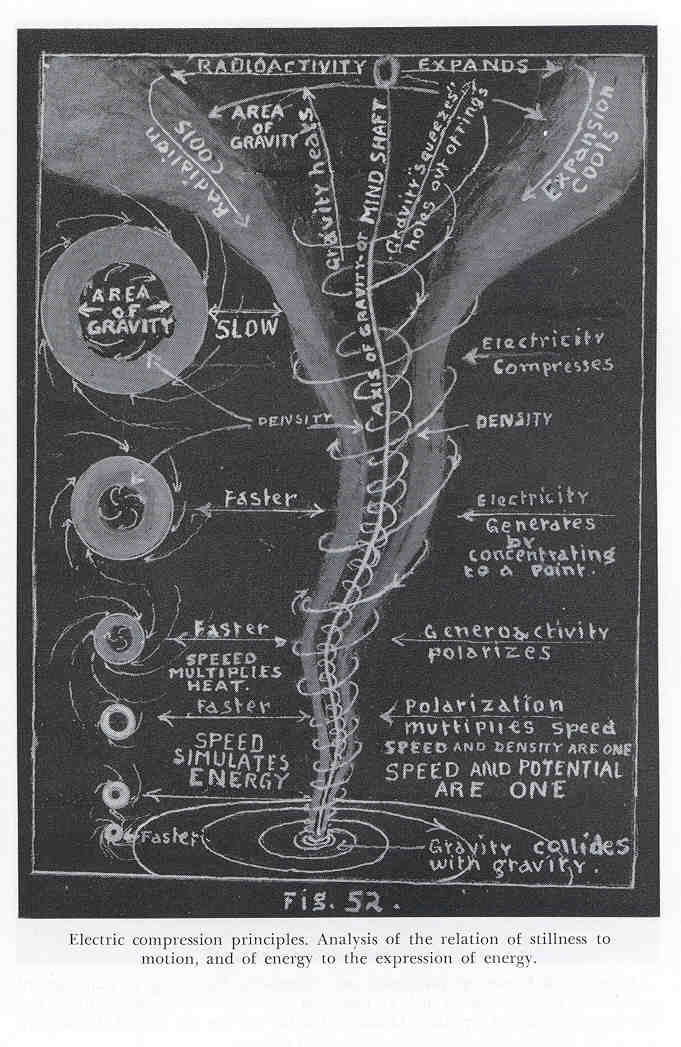Again, these are One Force moving in two opposite directions simultaneously and concurrently; i.e. reciprocally and proportionately. There can be no separating the One Force into two distinct forces although the One Force may appear to be one or the other at different times. The resultant motion is a spiraling inwardly and outwardly and spinning. If one polar axis is "tilted" (pulling on one pole and pushing on the other) there will be one polar flow. Simultaneously the structure becomes "twisted" (forming stria) and uniform containment is jeopardized. If two polar axis are "tilted" there will be a resultant polar flow at 90° to the first one.
Russell
"And you shall know that what emerges from one side of its equator is equal - but opposite to that which is on the other side - and that EACH WILL DISAPPEAR IN SEEMING DEATH TO REBORN EACH OTHER AS SEEMING LIFE. The anodes of the universe are likewise cathodes - and the cathodes are likewise anodes as surely as you, who breathe out, breathe in again to again breathe out - and as you who live, are dying as you live, and must forever die to forever live." [Home Study Course, Unit Seven. Lesson 25]

Figure 3.28 - Compression and Expansion Forces in Gyroscopic Motions.
(courtesy University of Science and Philosophy)
(click to enlarge)
See Also
state of turmoil
cycloid
cycloid motion
cycloid-space-curve
cycloid-space-curve-motion
cycloid-spiral-space-curve
earth
Earth Wobble
Figure 10.05 - Three Orthogonal Planes where Six Gyroscopic Vortices Converge
Figure 3.21 - Vortex or Gyroscopic Motions as Conflicts or Antagonisms between Light and Dark
Figure 3.22 - Vortex or Gyroscopic Motions as Conflicts or Antagonisms between Light and Dark Zones
Figure 3.23 - Vortex or Gyroscopic Motions as Conflicts or Antagonisms between Light and Dark Zones
Figure 3.28 - Compression and Expansion Forces in Gyroscopic Motions
Figure 3.30 - Discrete Degrees or Steps in Gyroscopic Compression Motion
Figure 4.5 - Compound Gyroscopic or Vortex Motions
Figure 5.3 - Vortex or Gyroscopic Motion is Natural and occurs ubiquitously
Figure 5.4 - Vortex and Gyroscopic Motion on One Plane then on three forming Sphere
gyroscope
gyroscopic principle
Gyroscopic Reactionless Drive
Levitating Gyroscopes
New Concept - Wobbling Gyroscopes Seek Balance
New Concept - XXXI - Introducing the Gyroscope into the Octave Wave
New Concept - XXXII - The Nucleus is the Hub of the Gyroscope Wheel
New Concept - XXXVI - Wobbling Gyroscopes Seek Balance
orbit
planet
Polarity Controlled Electric Gyroscope
spin
system of cycloid-space-curves
The Practical Application of Cycloid-Space-Curve-Motion arising from Processes of Cold Oxidation
Vortex
whirl
Schauberger
The outcome of this incessant reciprocal activity on the one hand is the reconstitution of the various kinds of water present in the individual zones, and on the other, the constant transformation of the species of vegetation in which water makes its way, ceaselessly moved by this inner interplay of forces. This inner, energetic interaction, however, is opposed by the effect of the water's weight. The alternating magnitudes of these component forces inevitably lead to the constant rising and falling of the water particles - the so-called pulsation of water. Every new formation and all growth is derived from the smallest beginnings. Continuing development in the early stages can only be accomplished if the circulation in the Earth's interior proceeds correctly. According to inner law, every higher form of vegetation is built up from the lower species preceding it. The carrier of the substances and the transmitter of the life-processes in the root-zone is the groundwater. The impulse for its movement is caused by a drop in temperature, to which the inner metabolic processes of the here decisive groups of basic elements give rise. The impulse for the movement of water is thus a product of the interactions between the opposites contained within it, which find their necessary resistance in the water itself. Through the resistance arising from the interactions between carbone and oxygen, fluctuations in temperature again occur and with them the impulse to move - the pulsation of water, which in this way at times dissolves salts and at others deposits them, transports them, creates energies and transforms them. The sense and purpose of these perpetual transformation processes is the creation and maintenance of the various types of vegetation and physical forms, which on their part again represent the bridges for the build-up and maintenance of the energies. [The Energy Evolution - Harnessing Free Energy from Nature, Conclusions]
See Also
Androgyny
Covariance
Conjugate Variables
Father-Mother Principle
Figure 3.10 - Temperature Accumulates in the North and Cools in the South Reciprocally
Figure 12.13 - Some Multi-Dimensional as Inverse and Direct Reciprocal Relationships
Figure 13.14 - Equilibrium as Reciprocal Forces
Law of Assimilation
Mate-Pairs
Multiplicative inverse
Polar
Reciprocal
Ramsay - The New Way of Reckoning a Vibration
Reciprocating Proportionality
Rhythmic Balanced Interchange
Sex
3.12 - Reciprocating Duality
3.13 - Reciprocals and Proportions of Motions and Substance
6.1 - Reciprocal Radiations
7.3 - Law of Love - Reciprocal Interchange of State on Multiple Subdivisions
7.6 - Reciprocal Disintegration and Creation
7.7 - Reciprocal States of Matter and Energy
12.00 - Reciprocating Proportionality
